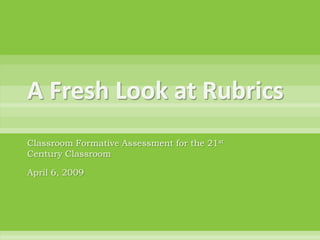A Fresh Look at Rubrics
•Télécharger en tant que PPTX, PDF•
0 j'aime•260 vues
Signaler
Partager
Signaler
Partager

Recommandé
Contenu connexe
Tendances
Tendances (19)
Course embedded assessment using goals, alignments and reporting

Course embedded assessment using goals, alignments and reporting
Special topic by Rosalie P. Mabana and Gemma Caranza(Authentic Assessment)

Special topic by Rosalie P. Mabana and Gemma Caranza(Authentic Assessment)
Principles of good practice in assessing learning outcomes

Principles of good practice in assessing learning outcomes
Alternative means of assessment and evaluations in inclusive classrooms

Alternative means of assessment and evaluations in inclusive classrooms
Similaire à A Fresh Look at Rubrics
Similaire à A Fresh Look at Rubrics (20)
Alternative means of assessments and evaluations in inclusive classrooms

Alternative means of assessments and evaluations in inclusive classrooms
Designing Meaningful Performance-Based Assessment.pptx

Designing Meaningful Performance-Based Assessment.pptx
A Fresh Look at Rubrics
- 1. A Fresh Look at Rubrics Classroom Formative Assessment for the 21st Century Classroom April 6, 2009
- 2. Target Understand the function and utility of rubrics Teacher-friendly rubric creation that’s also student-friendly Feedback v. grading Connection to the Seven Strategies
- 3. The indispensable conditions for improvement are that the student comes to hold a concept of quality roughly similar to that held by the teacher, is able to monitor continuously the quality of what is being produced during the act of production itself, and has a repertoire of alternative moves or strategies from which to draw at any given point. Sadler, 1989
- 5. Self-Assessment Rubrics They are general, rather than task specific They use descriptive language that helps students see what they are doing right as well as what needs work They are analytic rather than holistic in structure, if they are intended to address a complex or multidimensional learning target